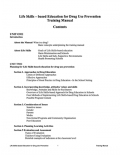What's New
Displaying results 4811 - 4820 of 4899
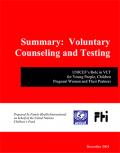
Resource | Publications,
There are no instant prescriptions on how to provide voluntary counseling and testing (VCT) for young people and children, as well as VCT for pregnant women and their partners. Further learning by doing and expanded partnerships in action are required. Effective and innovative responses to the psychosocial needs of young people and children (including counseling) require investment in addition to VCT services. The United Nation’s Children’s Fund (UNICEF) has a crucial role to play in this area.
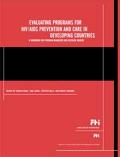
Resource | Tools,
Evaluation is too often an afterthought in the process of program implementation. This Handbook is dedicated to the premise that evaluation must be a critical part of the initial phases of planning effective HIV/AIDS prevention and care programs.
Readers of this Handbook will find that the authors have set the stage and provided the tools for a comprehensive and strategic approach to evaluation. The approaches they recommend yield useful and important information on the effectiveness of HIV/AIDS prevention, care, and support programs.
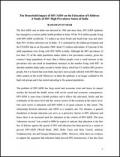
Resource | Publications,
The first AIDS case in India was detected in 1986 and since then, HIV/AIDS epidemic has emerged as a serious public health problem in India. Of the 39.4 million people living with HIV/AIDS worldwide, 7.1 million are from South and South East Asia and more than 70% of these infections are in India. It is estimated by the Indian government and the UNAIDS that as on December 2004, about 5.1 million individuals- 0.9 percent of the adult population were living with HIV/AIDS in India. Although the HIV prevalence of less than 1% of the adult population makes India a low prevalence country, given the country’s large population of more than a billion people, even a small increase in the prevalence rate can result in tremendous increases in the number living with HIV. In absolute numbers India ranks second to South Africa, which has 5.3 million HIV positive people, but it is feared that soon India may have more people infected with HIV than any other country in the world. Moreover, in India the epidemic is no longer confined to the high-risk groups and it has started spreading to the general population.
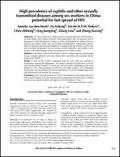
Resource | Publications,
In China, in the early 1980s, sexually transmitted diseases (STD) started to increase steeply. Sex workers and their clients appeared to play an important role in the spread of STD. Prostitution is illegal in China, and therefore no specific services exist for sex workers unless they are arrested and detained in re-education centres. Staff of a maternal and neonatal hospital in Guangzhou felt the need for an STD care and prevention programme for sex workers outside detention, and started a programme within their hospital, which was unique in the Chinese context.
Given the high prevalence of STD, the potential for the further spread of HIV is clearly present. STD care and prevention programmes for these women, outside detention, are urgently needed, and appear also to be feasible in China.
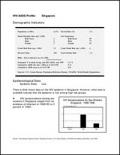
Resource | Fact Sheets,
There is little recent data on the HIV epidemic in Singapore. However, what data is available indicate that the epidemic is low among high risk groups. HIV seroprevalence among sex workers in Singapore ranged from no evidence of infection in 1986-93 to 2 percent in 1994.
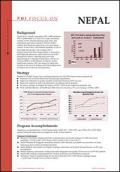
Resource | Fact Sheets,
Nepal faces a rapidly expanding HIV/AIDS epidemic. This is attributable to an active sex trade, increasing number of HIV infected injecting drug users, and substantial male labor migration. Recent studies confirm that Nepal has gone from a low-prevalence country to one with a concentrated epidemic in one or more high-risk groups. For example, HIV-1 seroprevalence has been rising rapidly in association with high risk behaviors, with current levels of 40% amongst the nation’s injecting drug users and approaching 20% amongst Kathmandu’s female sex workers (FSWs). In the absence of effective public health interventions, HIV prevalence in Nepal may increase to the level of making AIDS the leading cause of death in the 15-49 year old population.
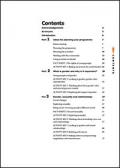
Resource | Tools,
This action kit is for young people and adults who run youth programmes that are looking at issues of sexual and reproductive health, such as life skills and HIV (Human Immuno-deficiency Virus). It aims to raise awareness of the importance of gender issues in sexual and reproductive health and to provide practical ideas for introducing gender aware- ness into existing youth programmes. There are sections that explain what gender is and how it affects our relationships and our sexual and reproductive health.
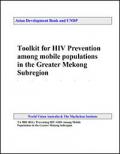
Resource | Tools,
This is a toolkit to guide the management and implementation of HIV prevention programmes for mobile populations in the Greater Mekong Subregion. It will be used by people and organisations who already have some experience in HIV prevention, and are now ready to address the specific challenges of working with mobile populations. Specifically, the toolkit addresses ways to work with mobile groups of construction workers, truck drivers, seafarers and migrant sex workers.
While the toolkit supports HIV prevention amongst mobile population groups, it also recognises that HIV is transmitted through interaction between mobile or migrant groups and the more stable communities they pass through, live in or return to. The toolkit therefore strongly recommends that effective HIV prevention will occur only when there are programmes for mobile groups and for the more stable communities with whom they interact.
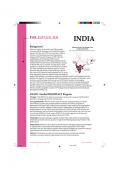
Resource | Fact Sheets,
India is a country of more than one billion people, seventeen official languages, and hundreds of ethnic groups. The first case of HIV was reported in 1986 in Chennai. The National government launched the National AIDS Control Program in 1987.






